UPSC Daily Current Affairs: 11th October 2024 | Current Affairs & Hindu Analysis: Daily, Weekly & Monthly PDF Download
GS3/Economy
NABARD Survey on Rural Financial Inclusion
Source: PIB
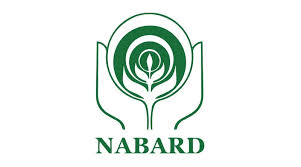
Why in News?
The National Bank for Agriculture and Rural Development (NABARD) has released the results of its second All India Rural Financial Inclusion Survey (NAFIS) for the period 2021-22.
About the NAFIS 2021-22
- The survey collected primary data from 100,000 rural households across 28 states and Union Territories, including Jammu & Kashmir and Ladakh.
- The first NAFIS was conducted for the agricultural year 2016-17, with results published in 2018.
- This survey offers crucial insights into rural economic and financial indicators, particularly in the context of the post-COVID environment.
Key Highlights from NAFIS 2021-22:
- Increase in Average Monthly Income
- The average monthly income rose by 57.6%, from Rs. 8,059 in 2016-17 to Rs. 12,698 in 2021-22, representing a nominal Compound Annual Growth Rate (CAGR) of 9.5%.
- Agricultural households reported a higher average income of Rs. 13,661 compared to Rs. 11,438 for non-agricultural households.
- Salaried employment was the primary income source for all households, contributing approximately 37% of total income.
- For agricultural households, cultivation was the main income source, making up about one-third of their monthly earnings.
- Non-agricultural households derived 57% of their income from government or private services.
- Rise in Average Monthly Expenditure
- Average monthly expenditure increased from Rs. 6,646 to Rs. 11,262 in 2021-22.
- Agricultural households had a higher expenditure of Rs. 11,710, compared to Rs. 10,675 for non-agricultural households.
- In states like Goa, monthly household expenditure surpassed Rs. 17,000.
- Overall, agricultural households exhibited both higher income and expenditure compared to their non-agricultural counterparts.
- Increase in Financial Savings
- Annual average financial savings grew to Rs. 13,209 in 2021-22, up from Rs. 9,104 in 2016-17.
- 66% of households reported saving money in 2021-22, a rise from 50.6%.
- 71% of agricultural households indicated they saved money, compared to 58% of non-agricultural households.
- States where 70% or more households reported savings include Uttarakhand (93%), Uttar Pradesh (84%), and Jharkhand (83%).
- States where less than half of households reported savings are Goa (29%), Kerala (35%), Mizoram (35%), Gujarat (37%), Maharashtra (40%), and Tripura (46%).
- Kisan Credit Card (KCC) Usage
- 44% of agricultural households possessed a valid Kisan Credit Card (KCC).
- Among households with land holdings greater than 0.4 hectares or those who had taken agricultural loans in the previous year, 77% held a valid KCC.
- Insurance Coverage
- The percentage of households with at least one member covered by any form of insurance increased from 25.5% to 80.3%, meaning four out of every five households had at least one insured member.
- Agricultural households had about 13 percentage points higher insurance coverage than non-agricultural households.
- Vehicle insurance was the most common, covering 55% of households.
- Life insurance coverage extended to 24% of households, with agricultural households slightly ahead at 26% compared to 20% for non-agricultural ones.
- Pension Coverage
- Households with at least one member receiving any form of pension rose from 18.9% to 23.5%.
- 54% of households with at least one member over 60 years old reported receiving a pension.
- Pensions included old age, family, retirement, or disability pensions, underscoring their role in supporting elderly family members.
- Financial Literacy
- Respondents demonstrating good financial literacy rose from 33.9% to 51.3%, an increase of 17 percentage points.
- Individuals exhibiting sound financial behavior increased from 56.4% to 72.8% during the same period.
- When assessed on financial knowledge, a significant proportion of rural and semi-urban respondents answered all questions correctly.
GS3/Economy
CAN INDIA ESCAPE MIDDLE-INCOME TRAP?
Source: The Hindu

Why in news?
The World Development Report 2024, published by the World Bank, emphasizes the issue of the "middle-income" trap, where economic growth rates tend to decline as countries experience rising incomes.
Background:
- In the past 34 years, only 34 economies classified as middle-income—those with per capita incomes ranging from $1,136 to $13,845—have successfully transitioned to higher income status.
Key takeaways
- The report outlines essential policies and strategies derived from the experiences of countries that have successfully navigated this transition.
- It underlines the significance of a "3i" approach: investment, infusion of new technologies, and fostering domestic innovation.
- Countries must focus on enhancing investments, adopting new global technologies, and creating a supportive environment for local innovation.
Role of the state
- Many countries that escaped the middle-income trap were part of the European Union, which facilitated capital and labor mobility among its members.
- Countries outside the EU, such as South Korea, have also successfully escaped the trap.
- The South Korean government took a proactive role, directing private sector activities and promoting an export-driven growth model.
- Successful enterprises received access to advanced technologies and state support, while underperforming firms were allowed to fail.
- Chile also escaped the trap, partly due to government intervention that bolstered its natural resource sectors, like the thriving salmon industry.
- Lessons from South Korea's approach suggest that the state should remain neutral among businesses, rewarding firms based on performance rather than political connections.
- Powerful business entities can drive growth if they commit to investing, adopting new technologies, and innovating.
The pitfalls
- South Korea's success rested on a manufacturing export strategy, which is no longer viable due to a slowdown in global export growth.
- Many nations have resorted to protectionism amid fears of job losses, leading to challenges in sustaining growth.
- Premature deindustrialization has affected multiple countries, with modern economies experiencing a decline in manufacturing's income share at lower GDP levels than past economies.
- Manufacturing is no longer the main driver of growth for developing economies, raising questions about whether the service sector can effectively replace it.
Challenges facing India
- The influence of billionaires in the Indian economy has grown, leading to perceptions of closeness to the state, which struggles to promote high domestic investment.
- The manufacturing sector has stagnated, reversing structural transformation, with employment rising in agriculture and low-productivity sectors following the pandemic.
- Despite government projections of approximately 7% real GDP growth in recent years, wage growth has been minimal for workers.
- For an economy to escape the middle-income trap, it is crucial that workers benefit from economic growth; otherwise, reduced consumer demand may hinder progress.
- South Korea's export strategy was managed by a military government until the 1980s, while Chile experienced a coup that deposed a democratically elected leader.
- It is essential to avoid misinterpreting these historical lessons, ensuring that the promotion of state intervention for growth does not compromise democratic values.
GS3/Environment
National Agriculture Code being formulated by Bureau of Indian Standards
Source: Indian Express
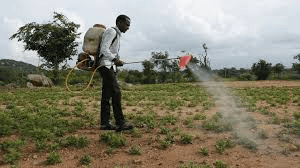
Why in news?
The Bureau of Indian Standards (BIS) has initiated the development of a National Agriculture Code (NAC), modeled after the existing National Building Code and National Electrical Code.
Standardized Agriculture Demonstration Farms
- About
- BIS serves as India's national standards body responsible for setting standards across various products and services and certifying these products.
- Operating under the Ministry of Consumer Affairs, Food and Public Distribution, BIS was established by the Bureau of Indian Standards Act, 2016.
- The headquarters of BIS is located in New Delhi.
- Objectives
- Foster harmonious development in standardization, marking, and quality certification of goods.
- Promote standardization and quality control to enhance industrial growth while addressing consumer needs.
- Activities
- Standards formulation: BIS formulates Indian Standards aligned with national priorities across various sectors.
- International activities: India, through BIS, participates in international organizations like the International Organization for Standardization (ISO) and the International Electro-technical Commission (IEC), and engages in regional and bilateral cooperation programs related to standardization, testing, and training.
- WTO-TBT Matters: BIS functions as the National Enquiry Point for Technical Barriers to Trade under WTO regulations.
- Product Certification: The presence of the BIS standard mark, commonly known as the ISI mark, signifies compliance with the relevant Indian Standard.
- Hallmarking: BIS initiated the hallmarking of Gold Jewellery in April 2000 to assure consumers of the purity of gold jewellery.
- Laboratory services and Training services: BIS also provides training through the National Institute of Training for Standardisation.
- Consumer Affairs and Publicity: Engaging in public awareness about standards.
- Background
BIS sets standards for various products in economic sectors, including agricultural machinery and inputs like fertilizers and pesticides. However, significant areas such as agricultural practices, micro-irrigation, and water management have not been adequately covered by existing BIS standards. Policymakers have recognized the necessity for a comprehensive framework of standards, which is now being developed by BIS.
- NAC Structure
The National Agriculture Code will encompass the entire agricultural cycle and provide guidance for future standardization. It will be divided into two main components:
- General principles applicable to all crops.
- Crop-specific standards focusing on paddy, wheat, oilseeds, and pulses.
- Objectives of NAC
- Create a national code for agricultural practices that considers various factors including agro-climatic zones, crop types, socio-economic diversity, and the entire agri-food value chain.
- Enhance a quality culture in Indian agriculture by offering a reference point for policymakers and agricultural regulators to incorporate NAC provisions into their frameworks.
- Serve as a detailed guide for farmers to make informed decisions regarding agricultural practices.
- Align relevant Indian Standards with agricultural recommendations.
- Address broader issues such as SMART farming, sustainability, traceability, and documentation.
- Support capacity-building programs run by agricultural extension services and civil society organizations.
- Coverage under NAC
The NAC will extend its standards beyond just agricultural machinery to include all agricultural processes and post-harvest operations. This includes:
- Crop selection and land preparation.
- Sowing and irrigation techniques.
- Management of soil and plant health.
- Harvesting and processing techniques.
- Record-keeping practices.
- Additionally, it will establish standards for managing inputs such as fertilizers, pesticides, and weedicides, as well as for crop storage and traceability. The NAC will also tackle emerging areas like natural and organic farming and the integration of Internet-of-Things (IoT) technologies in agriculture.
Proposed Timeline
- BIS has devised a strategy to standardize agricultural practices.
- Working panels will be composed of university professors and research organizations.
- Panels will draft the National Agricultural Code across 12-14 areas.
- The tentative deadline for finalizing the NAC is October 2025.
- BIS plans to conduct training sessions for farmers on the NAC and its standards.
- Universities will be encouraged to organize these training programs with financial support from BIS.
- BIS is establishing 'Standardized Agriculture Demonstration Farms' (SADF) at select agricultural institutes.
- SADF will test and implement practices based on Indian Standards.
- BIS intends to sign Memorandums of Understanding (MoUs) with 10 agricultural institutes.
- Two agreements are already in place, including one with Govind Ballabh Pant University of Agriculture and Technology (GBPUAT).
- Financial assistance will be provided for these farms, serving as practical learning sites.
- These sites will benefit officials, farmers, and industry representatives.
- Similar initiatives have been successfully implemented in China
GS3/Science and Technology
What is Footrot Disease?
Source: Indian Express

Why in News?
The footrot disease is causing significant mortality among the sheep and goats owned by Gaddi shepherds in Himachal Pradesh.
About Footrot Disease:
- Footrot is a highly infectious condition that affects the interdigital tissue (the area between the toes) of ruminants.
- This disease is one of the leading causes of lameness in cattle and sheep, leading to substantial economic losses.
- Once footrot infiltrates a herd or flock, it becomes extremely challenging to manage and control.
Causative Agent
- The disease is primarily caused by the bacteria Dichelobacter nodosus, often in conjunction with several other bacterial species.
Transmission
- Infected feet harboring D. nodosus serve as the primary source of infection, contaminating the environment.
- Infectious agents enter through skin lesions caused by sharp objects such as stones, metal, wood, stubble, or thorns.
- Footrot cases tend to peak during the wet seasons, indicating a seasonal pattern.
Symptoms:
- Severe and chronic lesions are indicative of virulent footrot disease.
- Infected animals may experience a decrease in production.
- In extreme cases, footrot can lead to death.
Treatment
- The interdigital tissue should be thoroughly cleaned, debrided, and disinfected to mitigate infection.
- A single course of antibiotic treatment is typically sufficient if administered promptly on the first day the disease is observed.
- Most animals show recovery within three to four days post-treatment.
GS2/International Relations
ASSOCIATION OF SOUTHEAST ASIAN NATIONS (ASEAN)
Source: The Hindu
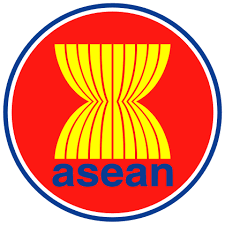
Why in News?
Prime Minister Narendra Modi recently arrived in Laos for a two-day visit, eager to engage in discussions with world leaders at the ASEAN-India and East Asia summits. He is set to participate in the 21st ASEAN-India and the 19th East Asia summits.
About ASEAN
- Established on August 8, 1967, in Bangkok, Thailand, through the ASEAN Declaration (Bangkok Declaration).
- Founding Members include Indonesia, Malaysia, the Philippines, Singapore, and Thailand.
- Current Membership consists of 10 countries: Brunei, Cambodia, Indonesia, Laos, Malaysia, Myanmar, the Philippines, Singapore, Thailand, and Vietnam.
- The Secretariat is located in Jakarta, Indonesia.
Objectives
- To enhance economic growth, social progress, and cultural development in the region.
- To foster regional peace and stability while adhering to justice, rule of law, and the principles outlined in the United Nations Charter.
- To encourage collaboration and mutual assistance on shared interests.
Key Principles
- The motto is "One Vision, One Identity, One Community".
- Non-interference in the internal affairs of member states.
- Commitment to peaceful resolution of disputes.
- Respect for the sovereignty and territorial integrity of all members.
- Promotion of a peaceful, free, and neutral environment.
Key Initiatives and Agreements
- ASEAN Free Trade Area (AFTA): Initiated in 1992 to facilitate trade liberalization among member nations.
- ASEAN Economic Community (AEC): Formed in 2015 to integrate member states into a unified market and production base.
- Regional Comprehensive Economic Partnership (RCEP): A major trade agreement including ASEAN members and five dialogue partners (China, Japan, South Korea, Australia, New Zealand; India decided not to join RCEP).
- ASEAN Regional Forum (ARF): A platform for discussing security issues across the Asia-Pacific region.
Significance
- Economic Powerhouse: ASEAN collectively represents one of the largest economies globally, characterized by diverse markets and strong trade ties.
- Strategic Importance: Positioned at key global maritime routes, the region plays a vital role in international trade and maritime security.
- India-ASEAN Relations: India maintains a robust strategic and economic partnership with ASEAN under the "Act East Policy", emphasizing enhanced connectivity, trade, and security cooperation.
Challenges
- Internal Diversity: Significant differences in political systems, economic development, and internal policies among ASEAN members can create challenges.
- South China Sea Disputes: Ongoing territorial conflicts primarily involving China and several ASEAN nations, especially Vietnam and the Philippines.
- Balancing Superpowers: ASEAN faces the challenge of managing the competing influences of China and the United States within the region.
India-ASEAN Engagements
- India became a sectoral dialogue partner of ASEAN in 1992 and achieved full dialogue partner status in 1996.
- The ASEAN-India Summit has been held annually since 2002.
- Trade in Goods Agreement (AITIGA): Signed in Bangkok in 2009 and effective from January 1, 2010.
- Trade in Services Agreement: This agreement was finalized in November 2014.
- Investment Agreement: Signed in November 2014 to enhance investment flows between ASEAN and India.
GS3/Environment
Wayanad Wildlife Sanctuary
Source: The Hindu

Why in News?
A recent two-day vulture survey conducted in the Wayanad Wildlife Sanctuary has documented the presence of 80 vultures across nine different locations.
About
- Wayanad Wildlife Sanctuary Location: Situated in Wayanad, Kerala, this sanctuary is part of the Western Ghats.
- UNESCO World Heritage Site: It is a crucial component of the Nilgiri Biosphere Reserve, recognized as a UNESCO World Heritage Site.
- Protected Borders: The sanctuary is bordered by the protected areas of Nagarhole and Bandipur in Karnataka to the northeast and Mudumalai in Tamil Nadu to the southeast.
- Indigenous Tribes: The forests are home to several scheduled tribes, including the Paniyas, Kattunaikkans, Kurumas, Ooralis, Adiyans, and Kurichiyas.
- Flora:The sanctuary showcases a diverse range of vegetation types found in the Western Ghats, including:
- Moist deciduous forests
- Dry deciduous forests
- Semi-evergreen patches
- Plantations: Approximately one-third of the area is covered by plantations of teak, rosewood, eucalyptus, and silver oak.
- Fauna:The sanctuary is home to a rich variety of wildlife, including:
- Elephants
- Panthers
- Tigers
- Jungle cats
- Civet cats
- Monkeys
- Wild dogs
- Bisons
- Deer
- Bears
- Tiger Population: Wayanad Wildlife Sanctuary is renowned for hosting the largest population of tigers in Kerala.
GS3/Environment
LIVING PLANET REPORT
Source: Times of India

Why in news?
The 2024 Living Planet Index report is out. The Living Planet Report stresses the need for a collective global effort to tackle the dual crises of climate change and biodiversity loss.
About Living Planet Report
The Living Planet Report is a comprehensive biennial publication by the World Wildlife Fund (WWF) that assesses the state of the planet’s biodiversity, ecosystems, and the impact of human activity on the natural world.
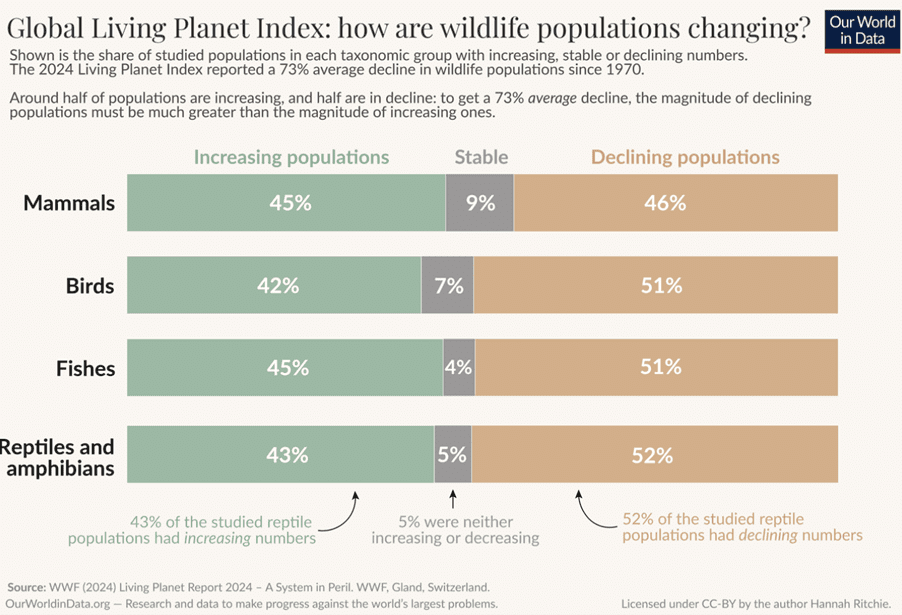
- Key Findings
- Biodiversity Decline: The report reveals a dramatic average decline of 73% in wildlife populations since 1970. This alarming trend is tracked through the Living Planet Index, which monitors the populations of thousands of vertebrate species worldwide.
- Ecosystem Role Disruption: When wildlife populations decrease significantly, their ability to perform crucial ecological functions—such as seed dispersal, pollination, and nutrient cycling—diminishes. This disruption can lead to a breakdown of ecosystem processes.
- Regional Impact: In India, the steep decline of three vulture species—the white-rumped vulture, Indian vulture, and slender-billed vulture—has raised significant concerns, as highlighted by WWF.
- Ecosystem Health: The report analyzes various ecosystems, including forests, oceans, and freshwater systems, revealing significant losses and degradation of habitats.
- Human Impact: It emphasizes human activities such as deforestation, pollution, climate change, and overexploitation of natural resources as primary drivers of biodiversity loss and ecosystem degradation.
- Major Themes
- Climate Change: The report highlights the urgent need to address climate change, which is further intensifying biodiversity loss and pushing ecosystems toward critical tipping points.
- Nature-Based Solutions: It advocates for implementing nature-based solutions to combat climate change and restore ecosystems, including practices like reforestation, sustainable agriculture, and conservation efforts.
- Sustainable Development: The report calls for the integration of biodiversity conservation into sustainable development goals and policies, ensuring that economic growth does not compromise environmental protection.
GS2/Governance
What is Humsafar Policy?
Source: Economic Times
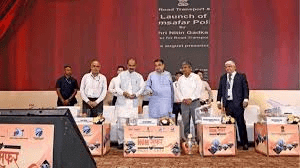
Why in News?
Recently, the Union Road Transport Minister introduced the 'Humsafar Policy', which is designed to enhance facilities along India's national highways. This initiative focuses on improving the convenience, safety, and comfort of travelers on these routes.
Objective of Humsafar Policy:
- The policy aims to provide essential amenities at frequent intervals along national highways to enhance traveler experience.
- It seeks to ensure that travelers have access to various services that promote their safety and comfort.
Amenities Provided:
- Rest stops will be established, featuring clean washrooms, food courts, parking areas, and first-aid services.
- Dedicated baby care rooms will be available, equipped with changing tables and other necessary items for families with young children.
Multi-Utility Spaces:
- These spaces will be strategically located along highways to meet the various needs of travelers.
- Facilities will include fuel stations, Electric Vehicle (EV) charging points, convenience stores, and more.
- The goal is to minimize driver fatigue and enhance road safety through these provisions.
Dormitory Facilities:
- Dormitories will be available at fuel stations, allowing truck drivers and long-distance travelers to rest comfortably during their journeys.
Accessibility Features:
- The initiative will prioritize accessibility, with wheelchair provisions for differently-abled travelers.
Sustainability Focus:
- The policy incorporates green technologies, such as solar-powered facilities and infrastructure for electric vehicles, aligning with India's environmental objectives.
GS3/Environment
 |
Download the notes
UPSC Daily Current Affairs: 11th October 2024
|
Download as PDF |
Red Panda
Source: PIB

Why in News?
The Red Panda Program of Darjeeling’s Padmaja Naidu Himalayan Zoological Park has been recognized as a finalist for the World Association of Zoos and Aquariums (WAZA) Conservation Award 2024.
About
- The Red Panda is primarily an herbivorous, shy, solitary, and tree-dwelling animal.
- It serves as an indicator species for ecological changes within its habitat.
- Its long, bushy tail aids in maintaining balance and provides warmth during winter by covering its body.
Appearance
- The Red Panda is comparable in size to a domestic cat and is well-known for its charming facial features and adorable defensive posture.
Distribution
- This species inhabits the mountainous forests across Bhutan, China, India, Myanmar, and Nepal.
- Approximately 50% of their natural habitat is located in the Eastern Himalayas.
Conservation Status
- IUCN Red List: Classified as Endangered.
- CITES: Listed in Appendix I.
- Wildlife Protection Act 1972: Protected under Schedule I.
Threats
- The loss of nesting trees and bamboo in the Eastern Himalayas is significantly impacting Red Panda populations, which is critical since nearly half of their habitat is found in this region.
GS1/Indian Society
Rise in life expectancy has slowed dramatically: New study
Source: Times of India

Why in news?
Recent research indicates that the increase in human life expectancy, which has historically been attributed to advances in medicine and technology, is now experiencing a significant slowdown. This study highlights that the impressive gains in life expectancy observed over the past decades may be reaching their limits, with substantial improvements in anti-aging treatments required for further increases.
Key Findings of the Study:
- Slowing of Life Expectancy Gains: The study reveals that, despite past increases due to medical advancements, the rate of growth in life expectancy has plateaued. Major breakthroughs in anti-aging medicine are necessary to achieve further significant extensions in lifespan.
- Regional Analysis: An analysis of life expectancy data from 1990 to 2019 in countries with long life spans, such as Australia, Japan, and Sweden, shows an average increase of only 6.5 years over 29 years.
- Challenges of Radical Life Extension: The research emphasizes that while healthcare improvements contribute to longer lives, the natural aging process—characterized by the decline of internal organ functions—poses a fundamental limit to lifespan. Even if major diseases like cancer and heart disease were eradicated, aging itself remains a significant hurdle.
- Low Probability of Reaching 100: The study estimates that girls born in the regions with the highest life expectancy have only a 5.3% chance of living to 100 years, while boys have a 1.8% chance. This suggests that achieving centenarian status remains rare without interventions aimed at slowing the aging process.
- Aging as the Primary Barrier: Researchers argue that substantial increases in average life expectancy will only be possible with breakthroughs that target the aging process itself, rather than merely improving treatments for prevalent diseases. Some experimental drugs, like metformin, have demonstrated potential in animal studies, but human trials are necessary.
India’s Present Status:
- Lower Life Expectancy: As of 2024, India's average life expectancy stands at approximately 70 years. In contrast, countries like Japan and Switzerland enjoy life expectancies of over 83 years.
- Healthcare Advancements: India has made notable progress in addressing infectious diseases and enhancing maternal and child health. However, chronic conditions and lifestyle diseases, such as heart disease and diabetes, are emerging as the primary causes of mortality.
What Needs to Be Done: (Way forward)
- Focus on Anti-Aging Research: India should allocate resources towards research in aging and regenerative medicine, seeking methods to decelerate the aging process instead of solely focusing on disease treatment.
- Strengthening Healthcare Systems: Enhancing access to quality healthcare and preventive services can help manage age-related diseases, improving the quality of life in older age, even if life expectancy does not see drastic increases.
- Policy Support for Longevity Research: There is a significant need for supportive policies that encourage medical research into life-extending technologies, including drug trials and studies focused on aging.
- Public Health Interventions: Implementing better public health strategies aimed at combating lifestyle diseases (like obesity and diabetes) and improving management of age-related conditions can positively impact life span and overall health.
- Mains PYQ:
- The increase in life expectancy in the country has led to newer health challenges in the community. What are those challenges and what steps need to be taken to meet them?
GS4/Ethics
ETHICAL LESSONS FROM THE LIFE OF RATAN TATA
Source: Indian Express

Why in news?
Former Tata Group Chairman Ratan Tata, whose dedication to integrity and social upliftment touched the hearts of many, breathed his last on Wednesday. Known for his ethical business practices and commitment to improving lives through social initiatives, Ratan Tata’s life serves as an example of how to bring change.
Key values, quotes and examples from his life
Kindness: Kindness is a fundamental virtue characterized by politeness and care for others. It involves empathy and compassion.
- During the 1984 anti-Sikh riots, Ratan Tata demonstrated remarkable kindness by providing free trucks to Sikh survivors. This support helped individuals rebuild their businesses during a time of great distress.
- Virtues like kindness and empathy are essential for fostering a positive environment and building trust, especially for civil servants interacting with diverse communities.
Spirit of Service: This quality reflects a person's commitment to public service without self-interest.
- In the aftermath of the 26/11 Mumbai attacks, Ratan Tata, as Chairman of Tata Group, took charge of the Taj Hotel's restoration and set up the Taj Public Service Welfare Trust to aid victims and provide long-term support.
Compassion: Defined as the emotional response to suffering, compassion involves a genuine desire to help others.
- Ratan Tata's love for animals, particularly dogs, is illustrated by a story shared by a visitor to the Taj Hotel, highlighting the staff's care for animals as a directive from Tata.
Leadership: Effective leadership involves guiding and influencing others, with a leader's values and ethics shaping organizational culture.
- Ratan Tata worked on the shop floor of Tata Steel after joining the company in 1961 to gain first-hand experience and understand operational challenges.
- He famously stated, “I don’t believe in work-life balance. I believe in work-life integration,” emphasizing the importance of harmonizing personal and professional goals.
Perseverance: This quality represents the steadfast pursuit of what is considered right, despite obstacles or delays.
- The Tata Nano faced several challenges prior to its launch, including protests that forced a relocation of the manufacturing plant, yet it was successfully launched in 2008.
- Tata's quote, “None can destroy iron, but its own rust can,” underlines the importance of a positive mindset in overcoming personal barriers and achieving potential.
Utilitarianism: This ethical principle posits that an action is right if it produces the greatest good for the greatest number.
- Ratan Tata envisioned the Tata Nano as a vehicle accessible to a wide audience, famously marketed as India’s first affordable car, priced at around Rs 1 lakh.
Philanthropy – Social Responsibility: Under Ratan Tata's leadership, the Tata Trust has demonstrated a profound commitment to social responsibility.
- Tata remarked, “I admire people who are very successful. But if that success has been achieved through ruthlessness, then I may admire that person less,” highlighting the importance of humane success.
GS3/Environment
Climate Risk Information System
Source: The Hindu

Why in news?
The Reserve Bank of India (RBI) has announced plans to establish a data repository called the Reserve Bank Climate Risk Information System (RB-CRIS).
Overview of Climate Risk Information System:
- The RB-CRIS aims to address the existing gaps in climate-related data, which is currently dispersed and inconsistent.
- Current climate data is marked by:
- Fragmentation across various sources.
- Diverse formats and units of measurement.
- Inconsistent frequency of data updates.
- Structure of RB-CRIS:
- The system will be divided into two main components:
- The first component will be a web-based directory that publicly lists various climate data sources, including meteorological and geospatial data.
- The second component will be a data portal that provides standardized datasets for user access.
- Phased Implementation:
- The RBI plans to roll out RB-CRIS in phases, starting with the web-based directory, followed by the gradual launch of the data portal.
- This phased approach is intended to help regulated entities adapt smoothly to the new system.
- Importance for Regulated Entities:
- It is essential for regulated entities to conduct climate risk assessments to maintain the stability of their balance sheets and the broader financial system.
- On February 28, 2024, the RBI issued draft guidelines for a 'Disclosure Framework on Climate-Related Financial Risks.'
- These guidelines require regulated entities (REs) to disclose information in four critical areas:
- Governance
- Strategy
- Risk Management
- Metrics and Targets
Objective of the Framework:
- The framework aims to provide stakeholders—including regulators, investors, and customers—with insights into the climate-related risks faced by REs and their strategies for managing these risks.
|
39 videos|4559 docs|977 tests
|
FAQs on UPSC Daily Current Affairs: 11th October 2024 - Current Affairs & Hindu Analysis: Daily, Weekly & Monthly
| 1. What is the NABARD Survey on Rural Financial Inclusion? |  |
| 2. How can India escape the middle-income trap? |  |
| 3. What is the National Agriculture Code being formulated by the Bureau of Indian Standards? |  |
| 4. What is Footrot Disease, and how does it affect livestock? |  |
| 5. What is the Humsafar Policy in India? |  |

































